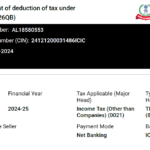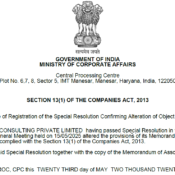GST Invoice Amendment: How Can It Be Done?
Table of Contents
ToggleGst Invoice Update: How to Rectify Mistakes?
GST invoice amendment refers to the correction or revision of errors or omissions made in the original GST invoice. The importance of this amendment lies in ensuring accurate reporting of tax liability, preventing any fraudulent activities related to invoicing, and compliance with the GST laws. Under GST, an invoice can be amended only once to rectify any errors or omissions within 180 days from the date of the original invoice.
How many times can a GST invoice be amended?
The amendment of GST invoice is restricted once only to ensure that the taxpayer provides accurate information in the first instance, and to prevent any misuse of the GST invoice system. This restriction also helps to maintain the integrity of the GST system by reducing the chances of any fraudulent activities related to invoicing.
GST rules about Amendment
Under the GST Act, the provision related to amendment of invoices is covered under Section 31(3)(a) of the Central Goods and Services Tax Act, 2017. This section provides that the supplier can amend the invoice only once to correct any errors or omissions.
The restriction on amending the invoice more than once is also mentioned in the GST Rules. Rule 53(1) of the Central Goods and Services Tax Rules, 2017, states that the supplier can amend the invoice only once to correct any errors or omissions.
What are the choice to amend more then 1 time?
However, it is important to note that in case of any errors or omissions in the invoice that are beyond the control of the supplier, such as the incorrect entry of the recipient’s details or the taxable value, the supplier can approach the GST authorities to rectify such errors under Section 161 of the Central Goods and Services Tax Act, 2017.
If an invoice under GST has already been amended once, and it needs to be amended again, then the following steps can be taken:
- Prepare a Debit Note or Credit Note: A Debit Note is issued when the tax liability on an invoice needs to be increased, while a Credit Note is issued when the tax liability needs to be reduced. The Debit Note or Credit Note should contain all the necessary details such as the original invoice number, date, and the reason for the amendment.
- Record the details in the GST Return: The details of the Debit Note or Credit Note must be recorded in the GST return for the relevant tax period. If the amendment results in an increase in the tax liability, then the additional tax amount must be paid along with the return.
- Communicate the Amendment to the Receiver: The amended invoice should be communicated to the receiver along with the Debit Note or Credit Note. The receiver can then adjust their input tax credit based on the amended invoice.
An example to illustrate how to correct an invoice amendment under GST:
Let’s say that a company issued an invoice for the sale of goods worth Rs. 10,000 on 1st January 2023, with a GST rate of 18% and a total tax liability of Rs. 1,800. The invoice number is INV001. This has been filed with GSTR1 (in Feb/2023)
However, later on (after filing the GSTR1 return), the company realized that they had made an error in the invoice and had charged an incorrect GST rate of 12% instead of 18%. To correct this, they made an amendment to the original invoice (INV001A) in March 2023 return, with the correct GST rate of 18% and a revised tax liability of Rs. 1,800.
But then, after filing of amendment of GSTR1 return, in March 2023, the company found that there was another mistake in the amended invoice. They had incorrectly calculated the taxable value, which should have been Rs. 9,000 instead of Rs. 10,000. To correct this mistake, they need to issue a Debit Note. (as this is the 2nd time correction, need to be made through Debit or credit note)
So, to correct the amended invoice, the company will follow these steps:
- Prepare a Credit Note: The company will prepare a Credit Note with the difference taxable value of Rs. 1,000, the correct GST rate of 12%, and a difference tax liability of Rs. 120. The Credit Note will mention the original invoice number (INV001) and the amendment number (INV001A), along with the reason for the correction.
- Record the details in the GST Return: The company will record the details of the Credit Note in their GST return for the relevant tax period, along with the tax liability of Rs. 120. If they have already filed their return, they will need to file a revised return to include the Credit Note.
- Communicate the Debit note to the Receiver: The company will communicate the amended invoice (INV001A) along with the Credit Note to the receiver of the goods/ Services. The receiver can then adjust their input tax credit based on the amended invoice/ Credit note.
If only the gst invoice number needs to be corrected in the example I provided, the following steps can be taken:
- Prepare a Credit Note: A Credit Note needs to be prepared with the original invoice number (INV001) and the amended gst invoice number (INV001A) mentioned on it. The Credit Note should contain all the necessary details such as the original taxable value, the original tax rate, the original tax amount, and the reason for the amendment.
- Prepare a new invoice with the correct invoice number: A new invoice needs to be prepared with the corrected invoice number and all the other details that were mentioned in the amended invoice (INV001A). The new gst invoice should also mention the Credit Note number.
- Communicate the changes to the receiver: The new gst invoice and Credit Note need to be communicated to the receiver of the goods. The receiver can then adjust their input tax credit based on the Credit Note and the new gst invoice.
It is important to note that any amendments to invoices under GST should be done within the prescribed time limit, which is generally within 180 days from the end of the financial year, or before filing annual return which ever is earlier.
Important Links –
Like Us On Facebook

Our Client's Review
EXCELLENTTrustindex verifies that the original source of the review is Google. Best place to file ur GST n IT returns .. They respond quickly, communicate well and get ur work done as per ur needs in a very short time ..Posted onTrustindex verifies that the original source of the review is Google. Best place for Income tax filingPosted onTrustindex verifies that the original source of the review is Google. Of all the CA, CS teams I have interacted with, they are the most prompt and organized. I have taken their services for almost 3 years now for various things like income tax queries, income tax filing, networth certificates, and compliance certificates. They always display a clear understanding of the law and are also able to explain it to you in layman terms. Overall a very resourceful and courteous team. Thank you for the support!Posted onTrustindex verifies that the original source of the review is Google. Best company secretary I bangalore ever seen such quick quality servicePosted onTrustindex verifies that the original source of the review is Google. Prakasha & Co has been a lifesaver for me when it comes to my tax dispute and filings with IT office. They are always very responsive and helpful whenever I have any questions or issues, I recently had an issue with my sister business GST filings, and they were able to quickly identify the issue and help me resolve it. They really go above and beyond to make sure their clients are taken care of.Posted onTrustindex verifies that the original source of the review is Google. ''The team at Prakasha& Co made sure my company was compliant with all the legal requirements. Their attention to detail and timely response was truly remarkable."Posted onTrustindex verifies that the original source of the review is Google. "I was impressed with the level of customer service provided by Prakasha& Co. They were always available to answer my questions and provide guidance throughout the company registration process."
Important Links
- Top 10 GST Registration Consultants in Bangalore
- Top 10 Best Income Tax Lawyers in Bangalore
- Top 10 Trademark Registration Consultants in Bangalore
- GST Registration in Bangalore
- Private Limited Company Registration in Bangalore
- Partnership Firm Registration in Bangalore
- Proprietorship Registration in Bangalore
- Trademark Registration in Bangalore
- Audit Frim in Bangalore
- CA Firm in Bangalore
- Accounting Services in Bangalore
- GST Lawyers in Bangalore
- Payroll Services Provider in Bangalore
- Payroll Consultant in Bangalore
- Income Tax Lawyer in Bangalore
All Categories
- Audit
- Blogs
- Bookkeeping Services
- Company Registration
- Company secretary Legal & Chartered Accountant
- Digital Signature Certificate (DSC) Services
- FSSAI Registration and Consultation
- GST
- Income tax
- Partnership Firm Registration
- Payroll Services
- Risk Management Services
- Startup Registration Process
- Trademark Registration
- Uncategorized








